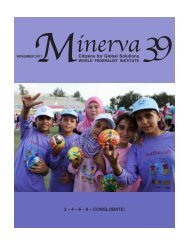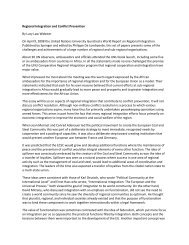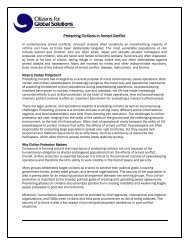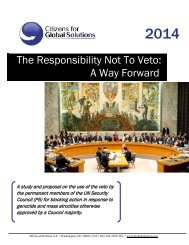Minerva, Spring 2008 (Volume 32) - Citizens for Global Solutions
Minerva, Spring 2008 (Volume 32) - Citizens for Global Solutions
Minerva, Spring 2008 (Volume 32) - Citizens for Global Solutions
You also want an ePaper? Increase the reach of your titles
YUMPU automatically turns print PDFs into web optimized ePapers that Google loves.
Indgrid Harder was a Policy Advisor<br />
on the Responsibility to Protect <strong>for</strong> the<br />
Government of Canada’s Department of<br />
Foreign Affairs and International Trade,<br />
where she worked on the Canadian-led<br />
campaign to build consensus on the Responsibility<br />
to Protect at the 2005 World<br />
Summit. Ms Harder has participated in<br />
numerous consultations and workshops<br />
on the Responsibility to Protect across<br />
North America, Europe and Africa. She<br />
previously worked in the Department’s<br />
African and Middle East Branch and as<br />
a consultant to the Treasury Board of<br />
Canada. Ms Harder holds an MA from<br />
the Norman Paterson School of International<br />
Affairs in Ottawa, Canada. She<br />
currently works as a Program Officer<br />
at the US Institute of Peace.<br />
This paper, initially commissioned <strong>for</strong><br />
the International Women Leaders <strong>Global</strong><br />
Security Summit 2007 (a project of the<br />
Annenberg Foundation Trust at Sunnylands<br />
in partnership with The White<br />
House Project, the Council of Women<br />
World Leaders and the Women Leaders<br />
Intercultural Forum), has been updated<br />
by the author <strong>for</strong> <strong>Minerva</strong>. The views<br />
expressed in it are those of the author<br />
alone, not of the Summit or its partners,<br />
of the Government of Canada, or of the<br />
United States Institute of Peace, which<br />
does not advocate specific policy positions.<br />
The Responsibility to Protect:<br />
Catchphrase or Cornerstone<br />
of International Relations?<br />
Ingrid Harder<br />
October 2007 (updated May <strong>2008</strong>)<br />
EXECUTIVE SUMMARY ~ In September 2005, world leaders unanimously agreed<br />
that states have an individual and collective responsibility to protect civilians from<br />
genocide and other crimes against humanity. This agreement, embodied in the final<br />
document of the 2005 World Summit, advanced the notion that there are indeed situations<br />
where sovereignty is not absolute – particularly when civilians are being attacked<br />
and slaughtered. Essentially, the “responsibility to protect” is the basis on which the<br />
international community can take collective measures – including the use of military<br />
<strong>for</strong>ce – in response to genocide and other crimes against humanity. Implementation of<br />
this principle, however, lags behind the rhetoric as crises such as Darfur challenge the<br />
commitment and capability of either governments or the international community to<br />
protect targeted populations.<br />
Closing this gap and giving real meaning to the responsibility to protect will require<br />
concerted ef<strong>for</strong>t to deepen the international commitment endorsed by the World Summit<br />
and to establish it firmly as a norm of international law. The international commitment<br />
to the principle remains fragile. There are still deep divisions – among member<br />
states and civil society groups – over exactly what was agreed upon, as well as how and<br />
when it should be applied. Solidifying this commitment and ensuring its implementation<br />
will require sustained advocacy at a high political level. Secondly, capacity needs<br />
to be developed at multiple levels to prevent or respond effectively to genocide and<br />
crimes against humanity. This means supporting institutional mechanisms such as the<br />
office of the United Nations’ Special Advisor on the Prevention of Genocide as well<br />
as improving operational preparedness to conduct military operations in the event that<br />
civilians require immediate protection.<br />
Women leaders and organizations focused on women and gender equality have succeeded<br />
in raising awareness of both the disproportionate impact of conflict on women<br />
and girls and the unique contribution women can make in the realm of peace and<br />
security. The responsibility to protect strongly complements existing commitments to<br />
protect women’s human rights and security and should be incorporated into existing<br />
work programmes and advocacy ef<strong>for</strong>ts.<br />
There is a pressing need <strong>for</strong> more champions worldwide, and in particular <strong>for</strong> women<br />
leaders, to add their voices and ef<strong>for</strong>ts to those who believe in and advocate <strong>for</strong> the<br />
protection of civilians from genocide and crimes against humanity.<br />
• Women heads of state can work to galvanize broader political support <strong>for</strong> the responsibility<br />
to protect through regional and other multilateral organizations, and focus attention<br />
on the responsibility of individual states to protect their own populations;<br />
• Senior officials can work to ensure that commitments to the responsibility to protect<br />
are institutionalized appropriately and incorporated into existing work programmes<br />
focused on women, peace and security; and<br />
• Women leaders in civil society need to help keep the spotlight where it belongs – on<br />
the development of effective strategies to prevent and respond to mass atrocities.<br />
Ultimately, it may be up to women leaders to move the responsibility to protect from<br />
a catchphrase that sounds right to its rightful position as a cornerstone of international<br />
relations in the 21st century.<br />
13 • <strong>Minerva</strong> #<strong>32</strong> • June <strong>2008</strong>













